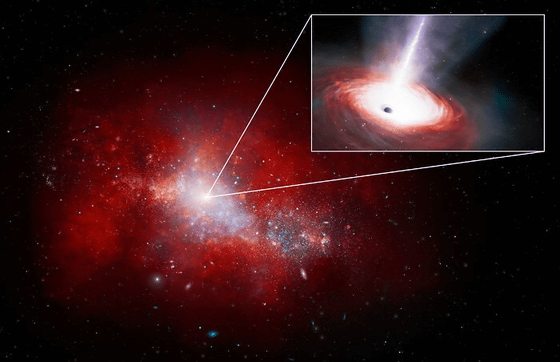Black hole LID-568 is growing at an astonishing rate, more than 40 times faster than the theoretical limit

by NOIRLab/NSF/AURA/J. da Silva/M. Zamani
A research team from the National Science Foundation's Optical and
A super-Eddington-accreting black hole ~1.5 Gyr after the Big Bang observed with JWST | Nature Astronomy
https://www.nature.com/articles/s41550-024-02402-9

NSF NOIRLab Astronomers Discover the Fastest-Feeding Black Hole in the Early Universe | NOIRLab
This Black Hole Is Eating Stuff at Over 40 Times The Theoretical Limit : ScienceAlert
https://www.sciencealert.com/this-black-hole-is-eating-stuff-at-over-40-times-the-theoretical-limit
noirlab2427a - YouTube
It has been observed that there is a supermassive black hole at the center of the galaxy, but it is not clear how this black hole grew to such a huge size. However, it is known that only 1.5 billion years after the Big Bang, The discovery that the later-born LID-568 was consuming matter rapidly offers insight into the mechanism by which black holes grew rapidly in the early universe.
LID-568 was discovered by a multi-institutional team of astronomers led by astronomer Hyewon Suh.
LID-568 cannot be seen in visible or near-infrared light, but the James Webb Space Telescope's Near-Infrared Spectrometer (NIRSpec) was able to detect faint X-ray emissions. However, the exact location could not be determined by X-ray observations alone, so a field spectrometer was used instead of the conventional slit spectroscopy. 'We couldn't have done this without the James Webb Space Telescope,' said Emanuel Farina, co-author of the paper. 'We were unable to detect LID-568, and using a full-field spectrometer was an innovative choice and was necessary to obtain the results we obtained.'
Artist's Impression of Fastest-feeding Black Hole in the Early Universe | NOIRLab
https://noirlab.edu/public/images/noirlab2427a/

by NOIRLab/NSF/AURA/J. da Silva/M. Zamani
By getting a full picture of LID-568 and its surrounding area, the team discovered that there is a violent gas ejection around the black hole, and the speed and size of the ejection suggest that LID-568 is experiencing a massive growth spurt. It is believed that most of the uptake may have occurred in a single burst, and it appears that LID-568 is taking in material at a rate 40 times faster than the Eddington limit .
The Eddington limit is the limit of balance between the radiation pressure from a black hole and gravity. When the tremendous light emitted by a black hole exceeds the gravity, surrounding matter stops falling into the black hole. Observations suggest that it is consuming matter at a rate far beyond that limit.
Julia Schallwächter, one of the study's co-authors, described LID-568 as 'feasting,' saying, 'Such extreme cases suggest that a rapid feeding mechanism beyond the Eddington limit must have existed in the early universe.' 'This suggests that this is one possible reason why a supermassive black hole has been observed.'
Current theory holds that supermassive black holes are formed either by dead stars ( light seeds ) or by the collapse of gas clouds (heavy seeds) in the early universe, but the results of this study suggest that they may be formed by much smaller It is said to provide new insights into the formation of supermassive black holes from black hole 'seeds.'
Related Posts:
in Science, Posted by logc_nt







